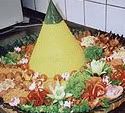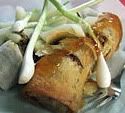
Mount Bromo
 Mount Bromo (Gunung Bromo, 2,392m) is an active volcano in the Bromo-Tengger-Semeru National Park of East Java, Indonesia.
Mount Bromo (Gunung Bromo, 2,392m) is an active volcano in the Bromo-Tengger-Semeru National Park of East Java, Indonesia.Understand
Bromo isn't the highest mountain in Java — that honor goes to nearby Mount Semeru at 3,676m — but it's probably the most famous one. Bromo is in fact only one of many peaks inside the massive Tengger Caldera, but it's easily recognized as the entire top has been blown off and the crater inside constantly belches white sulphurous smoke. The inside of the caldera, aptly dubbed the Laut Pasir (Sea of Sand) is coated with fine volcanic sand and the overall effect is unsettlingly unearthly, especially when compared to the lush green valleys all around the caldera.
Orientation
The major access point is Cemoro Lawang at the northeast edge, but there are also trails from Tosari (northwest) and Ngadas (west). The village of Ngadisari, on the road from Probolinggo about 5.5 km before Cemoro Lawang, marks the entrance to the national park. Both Cemoro Lawang and Ngadisari are rather picturesque, with brightly-painted houses and flower beds outside.
Get In
- By Plane. The nearest major airport is in Surabaya, three to four hours away by car (and more by bus).
- By Bus. The nearest larger town is Probolinggo, on the north coast of Java. It's about one hour from Probolinggo to Ngadisari and another half hour all the way to Cemoro Lawang, and it's (just) possible to visit on a day trip, although most visitors prefer to climb overnight and see the sunrise. To go there, take a 'Damri' shuttle bus from the Juanda International Airport in Surabaya, to go to the Bungurasih bus terminal(terminal Purabaya). Then, take an express Patas air-conditioned bus for a 2-3 hours ride from Surabaya to Probolinggo.
It's a fairly easy 3-km hike from Cemoro Lawang to the foot of Mount Bromo. Alternatively, you can hire a pony to do the drudge work for you, or have it even easier and do the trip by jeep. Private cars are not allowed inside the caldera. You can join the jeep package at Rp40.000 per person at the Probolinggo entrance office. On the next morning 4am, the jeep departs from hotel to catch the sunrise at Mount Batok (costs Rp40.000 per person for entering the compound). After the sunrise, go down to Mount bromo. You can hire a horse (Rp50.000) to bring you up and then You walk thru the last stair-case to reach the top of Mount Bromo.
- Unfortunately, some overly-enthusiastic crowd members can be rather annoying with their loud laughters and blinding flashes. Therefore, it would be pleasant, if everyone try to maintain a certain level of decency so that the "sun-rise watch" experience becomes more enjoyable.
When timing any activities in the area, bear in mind that sunset is soon after 5 PM and sunrise is correspondingly early at around 5:30 AM. This means you'll usually need to get up by 3:30 AM or so to get there in time for dawn.
- Mount Batok (2440m) is a brown volcanic cone at the north center of the caldera. Unlike the other nearby peaks it is no longer active and actually has some vegetation growing on it, mostly the local cemara tree that somehow manages to survive even on volcanic ash.
- Mount Bromo, edges tinged with white sulphur and always bubbling, is the main sight. To reach it on foot, pick the left fork at Cemoro Lawang's solitary crossing, then head down the ramp into the caldera and then across the caldera to the Hindu temple at the foot of the mountain. From the temple a steep path of 250 steps leads to the edge of the crater and a precarious meter-wide ledge from where to gaze into the volcano. Beware of local jeep-hirers, who often try to persuade tourists the journey to the mountain is not walking distance (in order to hire them jeeps, or horses). The walk from the tourist centre to the top of the mountain should take no longer than 1.5 hours by foot, and is about 3km.
- Mount Penanjakan (2770m), located just north of the caldera, is a mountaintop viewpoint accessible by paved road from Tosari and hence popular with jeeps and even tour buses. Most of the crowd comes to see the dawn at 5 AM, and you'll likely have the large concrete observation post to yourself if you arrive later in the day.
- Viewpoint #2, along the trail from Cemoro Lawang to Mt. Penanjakan, is an excellent way to get a stunning view of the caldera (see pictures above) without the crowds. To reach it, head west from Cemoro Lawang (past Cemero Indah) for 6 km, past farms and fields. The paved road eventually turns into a twisty mountain trail that ends with a flight of stairs on the right, and the viewpoint (with concrete shelter) is at the top. Allow 1.5 hours for the climb up at a steady pace, and bring along a torch if attempting this at night. From here, you can continue onto Mt. Penanjakan by following the trail upward, after which the trail merges onto the paved road to the viewpoint (total time about 60 minutes one way). If planning to return the same way, mark the spot where the trail emerges onto the road (if you pass a stone lantern on the way down, you've gone too far!), and note that descending on this section can get slippery due to loose sand and rocks.
Buy
The most popular local product, at least based on the number of hawkers selling them, appears to be the Bromo hat, a colorful wooly hat with "BROMO" embroidered on it. Scarfs and extra warm clothing are also popular, and useful if you are not prepared for the cold mountain air.
Eat & Drink
Every lodge has an attached restaurant, and simple roadside warung sell basic Indonesian dishes and mugs of hot Javanese coffee (kopi panas). There is no nightlife in the party sense of the word, but all restaurants are open at 3 AM as that's when everybody wakes up to see dawn over Bromo.
- Waroeng Basuki. Nice eatery serving many traditional Indonesian items like tahu tek (tofu/beancurd), rujak cingur (fruits with a sweet and spicy sauce garnished with ox-nose) and also serves Chinese food. Reasonably priced.
- Java Banana Bromo. It's a cafe with a very nice gallery, their specialty is in the coffee and banana snacks and drinks. Some traditional and western foods and beverages are also available.
There are plenty of accommodation options around the mountain. Facilities at Cemoro Lawang side of the caldera are rather basic, but there are good hotels in Sukapura and Probolinggo.
- Java Banana Bromo, Wonotoro, tel. +62-335-541193, A cozy boutique hotel with the beautiful landscape of Bromo. It's a lodge, cafe, and gallery. Room rates start from IDR 650,000 (Jan 2009).
- Bromo Cottages, Tosari, tel. +62-31-515253, Despite the name, it's actually an upmarket hotel. Net rates from US$47 for a double.
- Cemoro Indah, Cemoro Lawang +62-335-541019 (http://www.bromotrail.com) It has a nice view of Mount Bromo and provide hot water. You can sit down in its restaurant and view the Mount Bromo directly. An ecomomy room is 75,000rp.
- Lava View Lodge, Cemoro Lawang, tel. +62-335-541009. The most upmarket option in Cemoro Lawang, located at the caldera edge some 500m west of the village and price is more up than other hotels.
- Yoschi's, Ngadisari, tel. +62-335-541018. Cozy guesthouse done up to look like a Balinese temple. Note that the cheapest rooms here don't have hot water.
- Cafe Lava, Cemoro Lawang. This is the best budget option at 120,000 for an economy room.
Temperatures on Mount Bromo are refreshingly cool during the day (although sunburn is still a real danger), but outright cold at night, as temperatures can drop to zero in the summer and are rarely much above 5°C in winter. If needed, you can rent jackets and hats at Cemoro Lawang and the Penanjakan viewpoint for about Rp.5000.
Stay Safe
Mount Bromo really is a live volcano that erupts with disturbing regularity: in 2004, two tourists were killed and five injured when the mountain spit out molten rock as far as the temple. Keep your distance if the mountain is acting up.
Pay attention to the geologists who can normally accurately predict the state of the volcano and the associated danger level.
Get Out
All roads into Mount Bromo are dead ends, so you'll have to go back the way you came unless you are an experienced hiker and prepared to hike across the caldera to villages on the other side. (source)



















0 comments:
Post a Comment